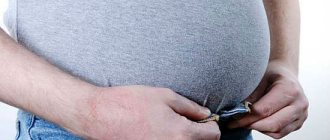Flatulence is a condition that is accompanied by the accumulation of excess gases in the digestive system due to increased formation or insufficient discharge. The anatomical and physiological characteristics of the child’s body are the cause of predisposition to functional disorders of the gastrointestinal tract, one of the manifestations of which is flatulence. Increased gas formation is a symptom of lower dyspepsia. In this condition, there are sensations of fullness, rumbling in the stomach, colic and flatulence - the process of passing gases.
Causes of occurrence in a child
Most often, functional gastrointestinal disorders occur in children of the first year as a result of complex adaptation to extrauterine life. Disorders are common in weakened children: premature, with an abnormal constitution, symptoms of rickets, chronic nutritional disorders.
Predisposing factors include:
- nature of food that is not age appropriate;
- sudden transition to artificial nutrition;
- a significant surplus in food of one type of nutrients (carbohydrates, proteins, fats);
- excessive or too frequent feeding.
Approximately 70% of the gas contained in a child’s digestive system is air, which is swallowed during crying, screaming, and feeding. Gases are also formed in the intestinal lumen with the participation of microorganisms that begin to colonize the gastrointestinal tract. Few gases (mostly nitrogen) diffuse from the blood as a consequence of the greatest partial pressure gradient between the intestinal lumen and blood plasma.
Forms of flatulence
The causes of gases in the intestines of a child determine the classification of flatulence into the following forms:
- nutritional. It manifests itself due to the consumption of foods, the digestion of which increases the release of gases (foods high in oligo- and polysaccharides). The development of this form is influenced by the rate of gastric emptying, the composition of the microbiocenosis, as well as the absorption capacity of the intestine. Aerophagia (swallowing air) also plays a significant role;
- digestive. This form is a consequence of disruption of digestive processes. Due to the imperfect functioning of enzyme systems, a large amount of under-digested substrates accumulates, exposed to the action of microflora with subsequent gas formation;
- dysbiotic. It progresses due to excessive microflora activity, which is associated with the fact that at an early age the mechanisms for suppressing excessive bacterial growth are ineffective. The processing of food by microorganisms occurs in the upper parts of the small intestine, and gases are released. And in the lower parts of the intestinal tract, putrefactive and fermentative processes are activated, gases are formed, peristalsis is inhibited;
- dynamic. Associated with impaired motor function of the digestive system. Gases do not escape and accumulate due to decreased motility, while undigested food components are metabolized by microflora, which is why gases continue to form. Flatulence is also dynamic, which occurs due to anomalies in the anatomy and localization of the colon (most often with elongation or pathological mobility);
- psychogenic. Occurs due to nervous disorders, excessive emotional anxiety of the child. When the nervous system is overexcited, hypertonicity and spasm of the smooth muscle structures of the intestine appear. Because of this, peristalsis is inhibited, pain syndrome develops, including colic;
- mixed. It appears due to several reasons.
Gases in a newborn: causes, symptoms, treatment
29.04.2021
Gas is common in newborns. They are caused by anaerobic fermentation, which is created by intestinal bacteria. The products of this process are gases such as hydrogen, methane and carbon dioxide. Gases are observed in those children who are fed breast milk. However, the cause of gas does not depend on the type of food the mother eats. A common cause of gas formation in a newborn is insufficient development of the child’s digestive tract.
Symptoms of gas in a newborn
The accumulation of gas in a newborn causes the symptom of a hard and bloated abdomen . In addition, the symptom of loss of gas in a newborn also includes abdominal , frequent belching and spilling of food contents. These symptoms are often accompanied by the characteristic flow of food into the abdominal cavity, and sometimes diarrhea. However, the presence of gas in a newborn does not always cause parents to panic, since their presence is determined by a number of other factors, such as whether they have an unpleasant odor. If so, then this is a sign of indigestion. However, if not, it may be a sign of improving bowel .
Causes of gas in a newborn
A common cause of gas formation in a newborn baby is intestinal colic. But there are other signs, and they are not necessarily associated with malfunctions in the child’s digestive tract.
One of the reasons for the appearance of gas breastfeeding technique . This is due to frequent breaks in feeding, which causes the baby to swallow too much gas . Another cause is hyperlactation, or galactorrhea. As a result, the baby drinks too much breast milk, which contains a large dose of lactose, and consumes too little final milk. That is, the child consumes more food than he really needs.
Gastrointestinal diseases such as gastritis , irritable bowel syndrome , diverticular disease and celiac disease may also be the cause. The cause of gas in a newborn baby may be insufficient development of the digestive tract. The baby's digestive tract develops 3-4 months after birth. The bacterial flora develops much later. The newborn baby also suffers from lactose intolerance and parasites.
Strong psychomotor agitation of the baby can provoke gas Stimuli that come from the external environment cause stress. All of these symptoms can be caused by certain medications that a nursing mother takes. On the other hand, if a child is fed not with mother's milk, but with modified food, this also leads to gas formation in the newborn, constipation or colic.
How to treat gas in newborns?
Treatment of gas in a newborn is based on the use of home methods, such as correct positioning of the child to remove excess gas. Place the newborn with his tummy on the parent's body so that the head is higher than the rest of the body. Also perform abdominal massage - make circular movements with one hand for a while, and semicircles with the other. During the massage, you can also slightly bend legs at the knee joints , pressing them to the stomach . This procedure makes it easier to remove accumulated gases .
However, if gas is recurring or bothersome frequently, it is best to visit a pediatric clinic . To find out the cause, the doctor prescribes a blood , stool examination, and ultrasound of the gastrointestinal tract. If the causes of gas in a newborn are diseases associated with the gastrointestinal tract, then the doctor will prescribe an endoscopic examination. As for drug treatment of gases , it consists of administering products containing simethicone. Also try teas containing chamomile or fennel, which act as a carminative and improve digestive tract function.
Prevention of gas in newborns
Gas in newborns is normal and not uncommon. They appear in almost all children, both in those who are fed breast milk and in those whose diet is based on feeding modified milk. A nursing mother should not eat foods that cause gas in the newborn. Also use proper feeding technique.
Published in Gastroentorology Premium Clinic
Symptoms of flatulence in a child
With flatulence, children may experience symptoms such as bloating, rumbling, flatulence and colic. Intestinal colic is a particular manifestation of abdominal pain syndrome. In infancy, with abdominal pain, the child becomes restless, screams, and refuses to breastfeed. In some cases, pain is manifested by rapid saturation and fullness of the stomach. Part of the pain with colic is associated with excessive gas formation and stretching of the intestinal walls. Due to gas filling of the gastrointestinal tract during feeding or during digestion, the intestines spasm and pain occurs.
First aid and treatment
The basis for the treatment of flatulence in children and colic caused by it is the following principles:
Correction of the cause of excess gas formation. A balanced diet must be selected. It is important to restore the intestinal biocenosis and cure pathologies of the upper gastrointestinal tract.
Removing accumulated gases from the intestinal lumen. To do this, the doctor prescribes the following medications for children for gases in the intestines:
- enhancing peristalsis (based on cumin, dill, fennel);
- adsorbents that absorb excess gases and remove them from the body (activated carbon, products based on dioctahedral smectite);
- defoamers, releasing gases from mucous vesicles, reducing the total volume of gas and facilitating passage.
There are also physical treatments for bloating and colic. What to do if a child has flatulence? It is recommended to keep the baby in an upright position or lying on his stomach on a warm diaper, with his legs bent at the knees. Stroking the tummy clockwise and massage are effective. The passage of stool and gas can be facilitated with a gas tube or an enema. The doctor may prescribe glycerin suppositories. The listed physical methods are effective as first aid for bloating in a child and colic.
Among experts, the question of the rationality of prescribing biological products and enzymes to children is controversial, although most often in the first months of life there is a slow formation of intestinal microbiocenosis, which confirms the advisability of using eubiotic agents.
How to deal with flatulence in older children
Bloating and gas formation in older children is not such a rare problem. An older child is already able to inform his parents about discomfort in the abdomen, but cannot accurately localize the place where the pain syndrome manifests itself due to the peculiarities of the innervation. Therefore, if your baby complains of pain, bloating, or discomfort, you should consult a specialist. Only a doctor can determine the cause of the illness and prescribe treatment.
For bloating and gases, children can be prescribed the same medications as at an early age: adsorbents, defoamers. Prebiotics are also used to correct intestinal dysbiosis. Enzyme preparations are used to correct digestive disorders. Children should be prescribed medicine for bloating by a pediatrician or gastroenterologist.
The cause of flatulence in childhood is often the consumption of “harmful” foods, sweet carbonated water, and an unbalanced diet in general. Therefore, diet therapy is a very important measure to eliminate digestive disorders.
Foods that cause flatulence
Products that most often cause increased gas formation:
- legumes of all types (white, red, brown), lentils of all types,
- all types of cabbage (white cabbage, broccoli, Brussels sprouts, kohlrabi, cauliflower),
- salads of all kinds,
- dairy products,
- onion,
- celery, parsley,
- garlic,
- asparagus,
- beets, carrots,
- bananas,
- raisin,
- grapes, apricots, plum juice, apples, plums,
- yeast bread (black, bagels, fresh bread, especially wholemeal bread), wheat germ,
- beer,
- nuts (pistachios and sesame),
- soybeans and soy products (tofu, soy milk).
These foods contain a lot of fermentable fructo-oligosaccharides - these are sugars that, when they enter the large intestine, begin to be intensively digested and form gases - wheat products, fruits rich in fructose (e.g. apples, pears), vegetables containing fructans (e.g. onions, asparagus ), products containing raffinose (e.g. legumes, beets), sorbitol (sugar-free chewing gum). Oats and potatoes can potentially cause flatulence because... rich in carbohydrates (sugars, starch).
The microbial composition of the intestine and peristalsis depend on the amount of polysaccharides consumed. Depending on the nature of the intestinal flora and the clinical picture of the disease, gas formation in the intestines is distinguished as fermentative, putrefactive and mixed.
All of them cause psychological discomfort and reduce a person’s quality of life.
Prevention
If the child is breastfed, then the mother should monitor her diet, do not overfeed the baby, and do not feed him too often. It is impossible to suddenly transfer children to artificial feeding and introduce complementary foods in excess quantities.
For older children, the recommendations are as follows:
- the child should eat regularly and balanced;
- eating should be slow, food should be chewed thoroughly;
- to prevent air from entering the gastrointestinal tract, you should not talk at the table;
- the child needs to move more to ensure good peristalsis of the digestive tract.
If alarming symptoms appear, you should immediately contact a specialist.
Diet rules for bloating
Diet as a way to get rid of bloating
When intestinal bloating occurs, nutrition should be structured in such a way as to minimize the formation of gases in the gastrointestinal tract and simplify the process of digesting food as much as possible.
The basic principles of nutrition for flatulence are as follows:
- The daily caloric intake should not exceed the required one. The number of calories necessary to maintain normal life functions is calculated taking into account the constitution, motor and mental activity, and age of the person. For an adult man, this norm is 2000-3000 kcal, for an adult woman - from 1800 to 2200 kcal. Children and older adults require fewer calories than adults.
- You need to leave the table feeling slightly hungry. The fact is that food does not begin to be digested immediately. This process takes from 2 to 4 hours depending on the condition of the body and the products consumed. Therefore, the feeling of fullness comes approximately 20-30 minutes after finishing a meal.
- The daily diet should be divided into 5-6 meals. There is an opinion that a portion of food should correspond to the size of a person’s fist. The last meal should be at least 4 hours before bedtime. 2-3 hours before going to bed, you can drink a cup of kefir or yogurt without sugar.
- Food should be served predominantly warm. Hot food irritates the walls of the stomach, and cold food slows down the digestive processes.
- Products should be consumed boiled and stewed, baked without fat or steamed.
- You can use fruits and permitted drinks as snacks, since these products are not recommended to be consumed with the main meal, so as not to cause fermentation in the stomach.
- It is recommended to cook foods without adding salt.
- In between meals, you need to take a sufficient amount of clean water (1 to 2 liters per day).
- Even the softest food requires thorough chewing. Its particles treated with saliva will be digested faster.
- While eating, you should not be distracted by talking, watching TV, reading or other extraneous activities. The body must be completely absorbed in the process in order to direct all its forces in the right direction.
- The diet should be planned depending on the diseases that accompany bloating and other symptoms (constipation, diarrhea, etc.).
In general, the above principles are not much different from the healthy diet that has become so widespread lately.










